 |
The Keep
Royal Naval Dockyard, Ireland Island, Bermuda
|
|
 |
Constructed: 1809-1845
Used by: Great Britain
Conflicts in which it participated:
None
|
Juan de Bermúdez (d. 1570) claimed the islands of Bermuda for the Spanish Crown upon their discovery in 1503. Bermúdez never actually landed on these islands (which would seem to be the least an intrepid explorer could do before claiming something for his monarch), but drew a recognizable map of the archipelago in question, which was good enough. The first Europeans to actually set foot on Bermuda were probably shipwrecked Portuguese sailors, around 1543.
|
 |
|
|
In 1609 elements of the Virginia Company, fresh from having founded Jamestown two years previously, were more or less driven ashore on Bermuda during a hurricane. Either because their ships were all destroyed or because Bermuda is awesome (except for the hurricanes), these Englishmen permanently settled there. Bermuda was thereafter administered by the Company as part of the Virginia colony, until it became an official British colony in 1707.
|
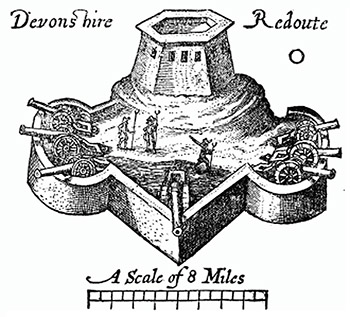 Devonshire Redoubt, one of Great Britain's earliest fortifications on Bermuda...perhaps a bit fancifully represented here. A scale of eight miles? Now that would have been a fort! 'Twas built in 1621, atop the remains of a previous work, built in 1619. Devonshire Redoubt, one of Great Britain's earliest fortifications on Bermuda...perhaps a bit fancifully represented here. A scale of eight miles? Now that would have been a fort! 'Twas built in 1621, atop the remains of a previous work, built in 1619. |
 |
Beginning in 1612, however, the Virginia Company set to work at the fortification of their new acquisition. Whether or not they were fully aware of Spain's claim to Bermuda, they certainly knew that the Spanish Navy was active in the area, and it would only be a matter of time before Spaniards came a-prowlin'.
The Company's first fortification was King's Castle, built by Bermuda's first Governor, Richard Moore, on Castle Island (at the mouth of Castle Harbor) in 1612. Much of this structure still stands today, making it the oldest standing British fortification in the New World.
It was King's Castle that deflected the only attempted Spanish incursion against British Bermuda, which event took place in 1614. Two Spanish ships were sighted just outside the channel to Castle Harbor, clearly with malevolent intent. Though King's Castle possessed only three cannonballs, it fortunately only took two, fired in the general direction of the ships, to convince the Spanish to depart...unfulfilled and likely undamaged. |
|
Bermuda remained a British backwater until the conclusion of the American Revolutionary War (1775-1783). Halifax, Nova Scotia had served as Great Britain's main naval base in the New World since about 1750, but its close proximity to a now independent and belligerent United States made it an increasingly insecure seat for British naval power. Through a process lasting from 1794 to 1818, Bermuda would become the home base for both the Royal Navy's North American and West Indies Squadrons.
By 1809, Ireland Island at the mouth of Bermuda's Great Sound was identified as the best spot for a heavily-fortified naval base, and work commenced, mostly utilizing slave labor. This involved some creative moralizing, as Britain's Slave Trade Act of 1807 had abolished the British slave trade...though had not gone so far as to outlaw slavery. Thus, as long as slaves needed for this project of vast strategic importance were purloined in some manner other than actually buying them (such as "confiscating" them from passing ships, or "liberating" them from America), everybody was happy. Except for the slaves.
|
As Great Britain's primary naval base in the Western Hemisphere, Bermuda would be littered with literally dozens of forts and batteries through the end of the 19th century. Anyone unclear on how determined the British were about defending their far-flung and minuscule imperial possessions might visit this site's Fortifications of Alderney page, or reference the Falklands War of 1982. Many of the most significant events of the War of 1812 involved Royal Navy squadrons that were based at Britain's new Royal Naval Dockyard, in Bermuda's Great Sound. |
 |
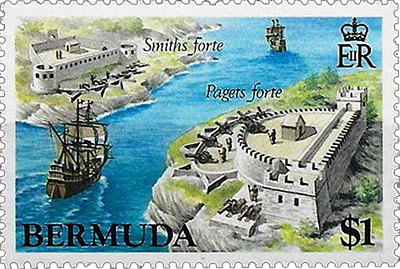 A couple of British Bermuda's many impressive fortifications, immortalized on a postage stamp. A couple of British Bermuda's many impressive fortifications, immortalized on a postage stamp. |
|
The bombardment of Fort McHenry at Baltimore, British dominance of the Chesapeake Bay and the burning of Washington DC were all accomplished by naval vessels whose home base would be protected by the semistarfort of our current interest, namely the Keep.  A woodcut of the ongoing construction of HMD (His/Her Majesty's Dockyard) Bermuda, A woodcut of the ongoing construction of HMD (His/Her Majesty's Dockyard) Bermuda,
printed in the Illustrated London News, July 29, 1848.
As they are wont to do, British military budgets shrank dramatically once the war was over, and HMD Bermuda languished incomplete until 1823, when convicts, mostly scurrilous Irishmen, began to be delivered to Bermuda. While seldom completely cooperative to the endeavor, this workforce proved directable enough to complete the dockyard's defenses by 1845.
|
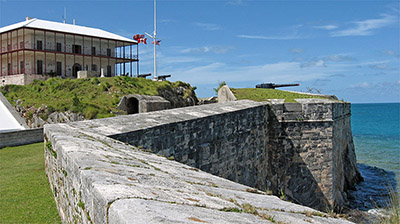 The eastern-facing wall of the Keep, the Commissioner's House, and a 6" RBL (Rifled, Breech Loading) gun. The eastern-facing wall of the Keep, the Commissioner's House, and a 6" RBL (Rifled, Breech Loading) gun. |
 |
Historically, a fortified residence and/or tower within a fortification (usually a castle) was known as a keep. This was the most stoutly constructed part of a fortification, which could be used as a refuge of last resort should one's fort be overrun, like the citadels we see in later starforts.
Such was the case with HMD Bermuda's Keep, which was built to house and defend both the Royal Navy's shot and powder stores and the house of the Commissioner of the Admiralty, where he who commanded the dockyard resided. |
|
Access to the fort was afforded by one of only three means: Through a sea gate, from whence powder and shot were lightered out to waiting warships; over a drawbridge covered by cannon; or over a temporary, removable bridge leading into northern rampart. Any of these entrances could be slammed shut in an instant should danger come to call.
Though it increasingly seemed as though the United States might provide that very danger, such a conflict never came to pass...although there is plenty of evidence that the United States was most certainly interested in what was going on, fortification-wise, in Bermuda. At least three American spies were sent to scrutinize Great Britain's efforts on Bermuda in the 1840's and 50's, sent on these missions by Daniel Webster (1782-1852), who was US Secretary of State of the Millard Filmore (1800-1874) administration; and our old starfort buddy Joseph Totten (1788-1864), the US Army's Chief of Engineers.
These spies found Bermudians and their British semioverlords to be distrustful of American and French visitors, suspecting that they had an interest in conquering Bermuda for their own purposes (which they most certainly did). Despite this, these spies returned home with detailed plans on how Bermuda's fortifications might most efficiently be defeated, as well as two large blocks of Bermuda's local "shell limestone," from which many of these fortifications had been built. It would be interesting to learn how Mr. American Spy managed to sneak that off the island!
The Keep and dockyard that it was built to protect had been created to defend Britain's 19th century Western Hemispheric foothold from the United States and France, but the 20th century changed everything. By the start of the First World War (1914-1918), Bermuda had become an important staging area and protective entity for convoys heading from the United States to Europe, specifically France.
|
 |
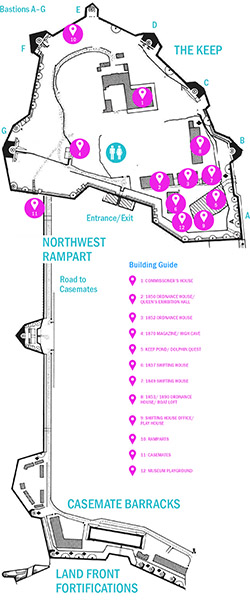 A handy map of the Keep from the National Museum of Bermuda's site. A handy map of the Keep from the National Museum of Bermuda's site. |
|
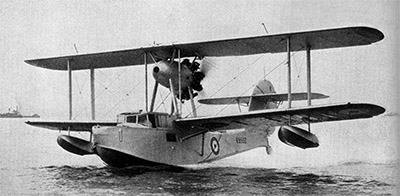 The Supermarine Walrus, flown by the Britain's Fleet Air Arm from 1933 through the Second World War. Ungainly-looking, yet effective. The Supermarine Walrus, flown by the Britain's Fleet Air Arm from 1933 through the Second World War. Ungainly-looking, yet effective. |
 |
Through the First- and Second World War (1939-1945), HMD Bermuda was utilized in this manner, helping to protect America's merchant marine convoys across the Atlantic. During the Second World War, several slightly ridiculous-looking Walruses (left), manufactured by the Supermarine aircraft company (creator of the world-renowned Spitfire), operated out of RNAS Boaz Island, just south of the Keep.
The end of HMD Bermuda came thanks to the United States, though not by the method imagined in 1809. |
|
During the Second World War, the United States was leased some portions of Bermuda for the purpose of building naval and air bases. After the war, responsibility for policing the world's oceans ceased to be Great Britain's bailiwick, the responsibility increasingly falling to the US Navy.
|
The Royal Navy maintained a presence at HMD Bermuda until 1958, when the region's future need of Britain's navy was decided unlikely...though a British supply of naval ammunition remained handy on the island until 1995. Perhaps fearing an attack by the Albanian Navy (actually a war with the Warsaw Pact would have meant more trans-Atlantic convoys), the United States continued to be based at Bermuda until after the Cold War: In 1995, the US Navy base was closed on the island.
Tourism to Bermuda picked up in the 1970's. Cruise ships began docking next to the Keep, which had been rotting since the British left it in 1958. |
 |
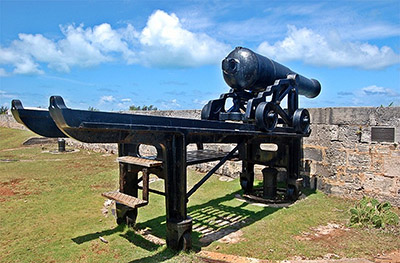 A British coast defense gun at the Keep, with an entertaining, self-repositioning carriage. A British coast defense gun at the Keep, with an entertaining, self-repositioning carriage. |
|
The Bermuda Maritime Museum took over the Keep in 1974. Initially some of the dockyard's buildings were renovated and opened as artist's shops, while restoration efforts got underway. Today, the Bermuda Maritime Museum occupies the Keep, and is Bermuda's largest museum, exploring Bermuda's history.  The view from the Commissioner's House in 2011: Some of the Keep's terreplein is visible. The view from the Commissioner's House in 2011: Some of the Keep's terreplein is visible.Endless thanks to alert starfort enthusiast Ben, who alerted us to the Keep!! |
|
|
|
|
|
 |




